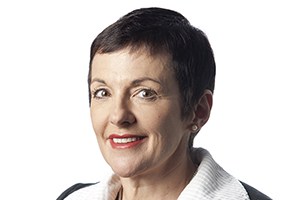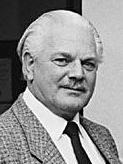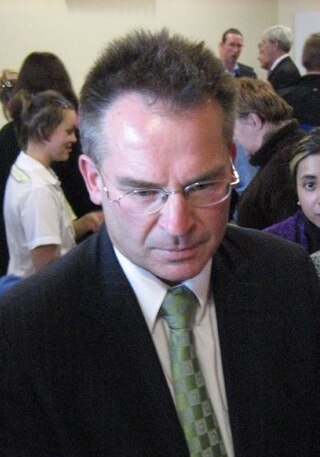
Anne Katherine Carnell is an Australian businesswoman and former Liberal Party politician, who served as the third Chief Minister of the Australian Capital Territory (ACT) from 1995 to 2000.

Gary John Joseph Humphries is a Deputy President of the Administrative Appeals Tribunal. He was a member of the Australian Senate representing the Australian Capital Territory for the Liberal Party of Australia from 2003 to 2013. He was the Chief Minister of the Australian Capital Territory from 2000 to 2001; and was elected to the first parliament of the Australian Capital Territory, in 1989, later representing the Molonglo electorate until 2003.
Rosemary Follett is a former Australian politician who was the 1st Chief Minister of Australian Capital Territory, serving in 1989 and again between 1991 and 1995. She was the first woman to become head of government in an Australian state or territory.
This is a list of members of the Australian Capital Territory Legislative Assembly from 1998 to 2001:

Trevor Thomas Kaine, was an Australian politician who served as Chief Minister of the Australian Capital Territory from 1989 to 1991. Kaine was elected into a multi-member single electorate in the unicameral Australian Capital Territory Legislative Assembly, from 1989 to 2001, initially as a member of the Liberal Party and later as an independent.
Elections to the 1989 Australian Capital Territory Legislative Assembly was held on Saturday, 4 March. This was the first direct election by voters in the Australian Capital Territory (ACT) for their power legislative body.
Elections to the Australian Capital Territory Legislative Assembly were held on Saturday, 21 February 1998. The incumbent Liberal Party, led by Kate Carnell, was challenged by the Labor Party, led by Wayne Berry. Candidates were elected to fill three multi-member electorates using a single transferable vote method, known as the Hare-Clark system. The result was another hung parliament. However the Liberals, with the largest representation in the 17-member unicameral Assembly, formed Government with the support of independents Michael Moore, Paul Osborne, and Dave Rugendyke. Carnell was elected Chief Minister at the first sitting of the fourth Assembly on 19 March 1998.

Elections to the Australian Capital Territory Legislative Assembly were held on Saturday, 20 October 2001. The incumbent Liberal Party, led by Gary Humphries, was challenged by the Labor Party, led by Jon Stanhope. Candidates were elected to fill three multi-member electorates using a single transferable vote method, known as the Hare-Clark system. The result was another hung parliament. However Labor, with the largest representation in the 17-member unicameral Assembly, formed Government with the support of the ACT Greens and Democrats. Stanhope was elected Chief Minister at the first sitting of the fifth Assembly on 12 November 2001. The election was conducted by the ACT Electoral Commission and was the first time in Australia's history that an electronic voting and counting system was used for some, but not all, polling places.

The Brindabella electorate is one of the five electorates for the unicameral 25-member Australian Capital Territory Legislative Assembly. It elects five members, and is the largest of the electorates in geographic area.

Elections to the Australian Capital Territory Legislative Assembly were held on Saturday, 18 October 2008. The incumbent Labor Party, led by Jon Stanhope, was challenged by the Liberal Party, led by Zed Seselja. Candidates were elected to fill three multi-member electorates using a single transferable vote method, known as the Hare-Clark system. The result was another hung parliament with Labor winning seven seats, the Liberals six seats and the Greens finishing with four seats, giving the Greens the balance of power in the 17-member unicameral Assembly. On 31 October 2008, after almost two weeks of deliberations, the Greens chose to support a Labor minority government. Consequently, Labor was re-elected to a third consecutive term of government in the ACT. Stanhope was elected Chief Minister at the first sitting of the seventh Assembly on 5 November 2008. The election was conducted by the ACT Electoral Commission.

Zdenko Matthew "Zed" Seselja is an Australian politician who was a Senator for the Australian Capital Territory from 2013 to 2022, representing the Liberal Party. He was the Minister for International Development and the Pacific in the Morrison government from December 2020 to May 2022, and previously served as an assistant minister in the Morrison and Turnbull governments since 2016.
The Australian Capital Territory House of Assembly was the main elected representative body of the Australian Capital Territory between 1975 and 1986, when preparations began to be made for the granting of self-government to the Territory. It served a largely advisory role, with most powers over the Territory still lying in the hands of the relevant federal minister through the life of the Assembly.
Craig John Duby, former Australian politician, was a member of the unicameral Legislative Assembly of the Australian Capital Territory between 1989 and 1992, elected to the multi-member single constituency Assembly as a representative of the No Self-Government Party. During his term in office, Duby was a member of the Independents Group and the Hare-Clark Independence Party. Duby was the Minister for Finance and Urban Services and briefly was the Minister for Housing and Community Services in the Kaine ministry. For part of one day, he served as the Leader of the Opposition.

Alistair Bruce Coe is an Australian politician and a former leader of the Liberal Party and Leader of the Opposition in the Australian Capital Territory (ACT). He was a member of the ACT Legislative Assembly from 2008 to 2021, representing the Ginninderra electorate from 2008 to 2016 and the Yerrabi electorate from 2016 to 2021. As Opposition Leader Coe led the Liberal Party to defeat at the 2020 election. He chose not to re-contest the party's leadership position, and resigned from the Assembly in 2021.
The Second Carnell Ministry was the sixth ministry of the Government of the Australian Capital Territory, and was led by Liberal Chief Minister Kate Carnell and her deputy, Gary Humphries. It was sworn in on 31 March 1998, after the Carnell government's re-election for a second term at the 1998 election. The ministry operated until 9 October 2000, when Carnell resigned as Chief Minister after being informed by key independent members, Paul Osborne and Dave Rugendyke, that they would no longer support her leadership due to her handling of the Bruce Stadium affair. Deputy Chief Minister Humphries was sworn in as her replacement, and Carnell subsequently left politics.
The First Carnell Ministry was the fifth ministry of the Government of the Australian Capital Territory, and was led by Liberal Chief Minister Kate Carnell and her three successive deputies, Tony De Domenico, Gary Humphries and Trevor Kaine. It was sworn in on 15 March 1995 after Carnell led the Liberal Party to its first ever election victory in the 1995 Australian Capital Territory general election.

The deputy chief minister of the Australian Capital Territory is the second-most senior officer in the Government of the Australian Capital Territory. The deputy chief ministership has been a ministerial portfolio since its establishment in 1989. Unlike in other states and territories, the deputy chief minister of the ACT is not nominally appointed by an administrator or vice-regal, but by the chief minister.

Elections to the Australian Capital Territory Legislative Assembly occurred on Saturday, 20 October 2012. The 11-year incumbent Labor Party, led by Chief Minister Katy Gallagher, won a fourth term over the main opposition Liberal Party, led by opposition leader Zed Seselja.

A general election for the Australian Capital Territory Legislative Assembly was held on Saturday, 15 October 2016.
The ACT Labor Party, officially known as the Australian Labor Party (Australian Capital Territory Branch) and commonly referred to simply as ACT Labor, is the ACT branch of the Australian Labor Party. It is one of two major parties in the unicameral Parliament of the Australian Capital Territory.










